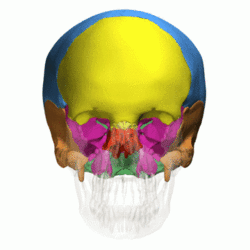
The Craniosacral System

The tree layers of membranes that surround the brain and spinal cord (meninges) plus the volume of cerebral spinal fluid constitute the craniosacral system. The tissues extend through the bones of the skull, face, and mouth (the cranium), and then down to the tailbone (the sacrum). This system protects the brain and spinal cord as a shock absorber, and also serves to facilitate the electro-chemical conduction of nerve signals.

As cerebral spinal fluid is produced within the brain itself, it swells the cranium cavity. The fluid is reabsorbed once reaching a certain pressure gradient and the brain narrows and contracts. This cycle creates the craniosacral rhythm, which can easily be detected throughout the body as the fluid courses through its pathways. The sensation of feeling this rhythm is similar to detecting the subtle movement of fluids within a full water balloon held in one’s hands.
Motion of the Cranial bones
Summary
Substantial support for life-long sutural patency and mobility of cranial sutures in healthy human beings is well established within the scientific and medical literature. Cranial bones can move small amounts, and do posse inherent rhythmic motion.
Having palpated the craniosacral rhythm with my own hands, I believe cranial sutures maintain flexibility that might best be called articulation. This flexibility allows the bones to move passively as they are driven by the craniosacral system.

Following are some videos for the illustration of this topic:
Cranium structure:
https://www.youtube.com/watch?v=hQ8mm5dH8zw
The breathing movements of the Cranium:
https://www.youtube.com/watch?v=J2oVjn2ALLE&list=PLdmaYmBxQweNQX4uW0ka6qkpZCGUL1T4k&index=1
In depth:
To appreciate the conceptual change implied by the concept of cranial bone motion, it is important to know that respected scientists, anatomists, and anthropologists posited the fusion and inherent immobility of cranial bones. They have held the view that cranial sutures were fused and immobile. Based on thorough examination of this debate, it may turn out that this view has been an anatomic version of “the world is flat” debate of the last millennium.
There is ample evidence that the cranial bones do rhythmically move a small but definite amount. Cranial bone motion in animals and humans is well documented. For example, Frymann (1) developed a non-invasive apparatus for mechanically measuring the changes in cranial diameter. She was able to conclude that a rhythmic pattern of cranial bone mobility exists and occurs at a rate that is different than that of thoracic respiration. This work was later cited by NASA scientists.
Russian Space Research
Assessment of cranial bone motion carried out by the Russian cosmonaut programs used various types of radiographic (x-ray) and ultrasound equipment.
After being introduced to OCF, Moskalenko and associates carried out several studies which illustrated cranial bone motion. He demonstrated (2), via NMR tomograms, cranial bone motion between 380 microns to 1 mm, and cranial cavity volume increases by 12-15 mL, with a rhythmicity of 6-14 cycles per minute.
Moskalenko (3) demonstrated that these oscillations, “…were of intracranial origin and were related to the mechanisms of regulation of the blood supply to and oxygen consumption by cerebral tissue, as well as with the dynamics of CSF circulation.”
US Space Research
In their summary, the NASA research team stated, “Although the skull is often assumed to be a rigid container with a constant volume, many researchers have demonstrated that the skull moves on the order of a few µm in association with changes in intracranial pressure.” (4, 5)
Recent Osteopathic Research on Cranial bone Motion
When palpatory assessment of cranial bone motion is compared with simultaneous Laser Doppler Flowmetry technology, striking correlations have been found.
References:
(1) Frymann VM. A study of the rhythmic motions of the living cranium. J Am Osteopath Assoc. 1971;70:1-18
(2) Moskalenko YE, Kravchenko TI, Gaidar BV, et al. Periodic mobility of cranial bones in humans. Human Physiology. 1999;25(1):51-58.
(3) Moskalenko YE, Frymann VM, Weinstein GB, et al. Slow rhythmic oscillations within the human cranium: phenomenology, origin, and informational significance. Human Physiology. 2001;27(2):171-178.
(4) Ueno T, Ballard RE, Shuer LM, Yost WT, Cantrell, Hargens AR. Noninvasive measurement of pulsatile intracranial pressure using ultrasound. Acta Neurochir. 1998;[Suppl]71:66-69.
(5) Ueno T, Ballard RE, Macias BR, et al. Cranial diameter pulsation measured by non-invasive ultrasound decrease with tilt. Aviation, Space and Environmental Medicine. 2003;74(8):882-885
Sources:
“Research: The Inherent Rhythmic Motion of the Cranial Bones”
http://vqs751.pair.com/stevens3/cranialfoundation/pdf/CranialBoneMotion.pdf
“CranioSacral Therapy: Helping Improve Brain Function”
http://www.iahe.com/images/pdf/Brain.pdf
“Craniosacral Therapy… What is it Really?”
http://www.iahe.com/images/pdf/Craniosacral_TherapyWhat_is_it_Really.pdf
“The Controversy of Cranial Bone Movement”